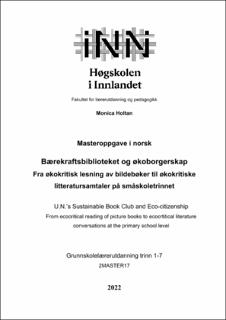| dc.contributor.advisor | | |
| dc.contributor.author | Holtan, Monica | |
| dc.date.accessioned | 2023-04-24T16:11:42Z | |
| dc.date.available | 2023-04-24T16:11:42Z | |
| dc.date.issued | 2022 | |
| dc.identifier | no.inn:inspera:109713146:31185310 | |
| dc.identifier.uri | https://hdl.handle.net/11250/3064646 | |
| dc.description.abstract | Norsk sammendrag
I denne studien tar jeg for meg tre bildebøker og ser dem i sammenheng med Kunnskapsløftets (LK20) nye, tverrfaglige mål om bærekraftig utvikling i norskfaget (Kunnskapsdepartementet, 2019). Målet er å fostre økoborgere som kan leve et mer bærekraftig liv enn tidligere generasjoner har gjort, slik at vi får en «utvikling som imøtekommer dagens behov uten å ødelegge mulighetene for at kommende generasjoner skal få dekket sine behov» (FN-sambandet, 2021b). Fra boklista (vedlegg 1) til FNs niende bærekraftsmål: Vi må «[b]ygge solid infrastruktur og fremme inkluderende og bærekraftig industrialisering og innovasjon» (FN-sambandet, 2022a), valgte jeg ut tre bildebøker. De tre bildebøkene er To veier av Martins og Carvalho (2009/2020), Ulla og Bendik bygger by av Johnsen (2015) og Tunellen av Siri og Johnsen (2015). Min problemstilling er: Hvordan kommer bærekraftige perspektiver og økoborgerskap til uttrykk i et utvalg skjønnlitterære bildebøker, og på hvilke måter kan disse bøkene og økokritiske litteratursamtaler om dem fremme bevissthet om bærekraft på småskoletrinnet? Studien besvarer problemstillingen ved hjelp av en økokritisk bildebokanalyse og en didaktisk drøfting om bruk av bildebøkene i økokritiske litteratursamtaler i klasserommet. Inspirert av Cheryll Glotfelty (2015) har jeg fokusert min økokritiske bildebokanalyse gjennom fire forskningsspørsmål. Jeg undersøker hvordan forholdet er mellom mennesker og natur, hvordan naturen fremstilles og er en del av plottet og hvordan bildebøkene formidler økologiske endringer. Jeg støtter meg til ledende bildebokteoretikere som Nikolajeva og Scott, resepsjonsteoretikere som Rosenblatt og Langer og Buell og Garrard fra det økokritiske teorifeltet. Nordisk forskning på barnelitteratur og økokritikk er i sterk framvekst, og jeg har fulgt pågående forskning utført av blant andre Natur i barnelitteratur og -kultur-gruppa (NaChiLitCul) med Goga et al.. Bildebokanalysene viser at enhver tekst kan leses økokritisk, og at økokritiske litteratursamtaler kan bidra til en dypere forståelse og en økt bevissthet omkring bærekraft og økoborgerskap. | |
| dc.description.abstract | Engelsk sammendrag (abstract)
In this study, U.N.’s Sustainable Book Club and Eco-citizenship: From ecocritical reading of picture books to ecocritical literature conversations at the primary school level, I consider three picture books and see them in connection with the Knowledge Promotion's (LK20) new, interdisciplinary goals for sustainable development in the Norwegian subject (Kunnskapsdepartementet, 2019). The goal is to foster eco-citizens who can live a more sustainable life than previous generations have done, so that we get a development of today without destroying opportunities for future generations (FN-sambandet, 2021b). I selected three picture books from the book list (Appendix 1) of U.N.´s ninth sustainability goal: We must "[b]uild resilient infrastructure, promote inclusive and sustainable industrialization and foster innovation" (United Nations, 2022). The three picture books are To veier [Two Roads] by Martins and Carvalho (2009/2020), Ulla og Bendik bygger by [Ulla and Bendik Build a Town] by Johnsen (2015) and Tunellen [The Tunnel] by Siri and Johnsen (2015). My main issue is: How are sustainable perspectives and eco-citizenship expressed in a selection of fictional picture books, and in what ways can these books and ecocritical literature discussions about them promote awareness of sustainability at the primary school level? The study answers the problem with the help of an ecocritical picture book analysis and a didactic discussion about the use of the picture books in ecocritical literature conversations in the classroom. Inspired by Cheryll Glotfelty (2015), I have focused my ecocritical picture book analysis through four research questions and examine how the relationship between humans and nature is, how nature is portrayed and is part of the plot and how the picture books convey ecological change. I rely on leading picture book theorists like Nikolajeva and Scott, reception theorists such as Rosenblatt and Langer and Buell and Garrard from the ecocritical field of theory. Nordic research on children's literature and ecocriticism is growing rapidly, and I have followed ongoing research conducted by, among others, the Nature in Children’s Literature and Culture group (NaChiLitCul) with Goga et al.. The picture book analysis show that any text can be read ecocritically, and that literature discussions can contribute to a deeper understanding and an increased awareness of sustainability and eco-citizenship. | |
| dc.language | nob | |
| dc.publisher | Inland Norway University | |
| dc.title | Bærekraftsbiblioteket og økoborgerskap:
Fra økokritisk lesning av bildebøker til økokritiske litteratursamtaler på småskoletrinnet | |
| dc.type | Master thesis | |
